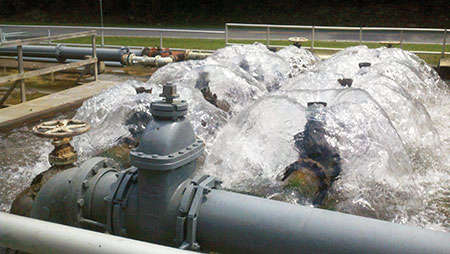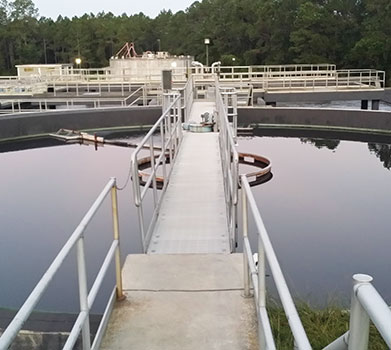Scope of Section 22 applies to the installation of electrical equipment “in locations in which corrosive liquids, vapours, or excessive moisture are likely to be present.”
Section 22 also covers installation of electrical equipment in sewage lift and treatment plants. Areas covered by Section 22 are classified as Category 1 or Category 2 locations. Code users should be able to classify the respective areas accordingly based on the definitions of Category 1 or Category 2, and select types of electrical equipment and wiring methods, as appropriate for the established Category.
In addition, sewage lift and treatment plants must also be classified for hazardous areas in accordance with Section 18.
So, at the first glance, everything should be reasonably simple for the purpose of applying appropriate requirements of Section 22.
However, there appears to be some confusion in respect to the application of installation requirements in wet locations in conjunction with the installation requirements in Category 1 locations.
Apparently, there is also a degree of confusion as to whether a typical sewage lift and treatment plant must be automatically classified as Class I hazardous location.

Let’s deal with a couple of illustrations of such confusion.
One traditional example of confusion is vehicle washing areas in industrial or commercial facilities. Some Code users are under the impression that a typical industrial or commercial vehicle washing area should not be covered by Section 22, as it is not necessarily a Category 1 location, and it is not shown among the examples in the Appendix B Note Table on Rule 22-002. Arguments are made that even if a vehicle washing area should be considered to be “wet location”, the “wet location” is not necessarily a “Category 1” location, and the relevant provisions of Section 22 for Category 1 location are not applicable.
Perhaps, before analyzing the relationship between “wet location” and “Category 1 location,” let’s review the Code definitions in conjunction with this subject.
“Wet location — a location in which liquids may drip, splash, or flow on or against electrical equipment.”
“Category 1 — the location is one in which moisture in the form of vapour or liquid is present in quantities that are liable to interfere with the normal operation of electrical equipment, whether the moisture is caused by condensation, the dripping or splashing of liquid, or otherwise.”
It should be noted that the NEC offers a more comprehensive definition of “wet location,” and it uses vehicle washing areas as an example of wet location as follows:
“Location, wet. Installation underground or in concrete slabs or masonry in direct contact with the earth; in locations subject to saturation with water or other liquids, such as vehicle washing areas; and in unprotected locations exposed to weather.”
It should be also noted that although definition “Category 1” does not explicitly reference “wet location,” it could be seen from the Category 1 definition that attributes of a typical wet location are already included in the Code definition of Category 1 location. (Category 1 location is such area where moisture or liquid is present in quantities that may interfere with the normal operation of electrical equipment, regardless whether such moisture or liquid is a result of condensation or the result of spraying, splashing or dripping).
Furthermore, Rule 22-200 references “wet locations” in requirements for wiring methods in Category 1 locations.
Therefore, there should be no doubt that electrical equipment in the areas of industrial or commercial vehicle washing facilities must be covered by the applicable provisions of Rule 22-100 – 22-108, and the wiring methods in the vehicle washing areas must be covered by Rule 22-200.
Of course, the referenced Table in Appendix B represents only some examples (but far from all possible illustrations) of Category 1 Location.
However, there is also no doubt that Appendix B Table on Rule 22-002 could be (and should be) expanded to include such areas as car/vehicle wash and other similar industrial washing faculties.
Let’s now review provisions of Section 22 regarding areas classification of a sewage lift and treatment plant.
The CE Code offers the following definitions and classification requirements:
“22-702 Special terminology
In this Subsection, the following definitions apply:
Continuous positive pressure ventilation — a ventilation system capable of maintaining a positive pressure in a room or area and of changing the air in the room or area at least six times an hour with means for detecting ventilation failure.
Dry well — the location below ground designed to accommodate equipment associated with wastewater pumping and isolated from the wet well location to prevent the migration of gases and vapours into the dry well.
Suitably cut off — an area rendered impermeable and cut off from an adjoining area with no means of liquid, gas, or vapour communication between the areas at atmospheric pressure.
Wet well — the location below ground where the raw sewage is collected and temporarily stored before passing through the lift pumps or being processed in a treatment plant.
22-704 Classification of areas (see Appendix B)
(1) Sewage lift and treatment plants shall be classified for
(a) hazardous areas in accordance with Section 18; and
(b) corrosive liquids, vapours, or moisture in accordance with this Section.
(2) Wet wells provided with adequate continuous positive pressure ventilation shall be considered Class I, Zone 2.
(3) Except as permitted by Subrule 5(c), all locations below ground suitably cut off from locations in which sewage gases may be present shall be considered Category 1.
(4) All locations in which sewage gases may be present in explosive concentrations shall be considered hazardous areas and Category 2.
(5) The following areas shall be permitted to be classified as ordinary locations:
(a) all locations suitably cut off from a Category 2 location and not classified as a Category 1 location;
(b) all locations not suitably cut off from a Category 2 location but with adequate continuous positive pressure ventilation; and
(c) dry well locations below ground where adequate heating and adequate continuous positive pressure ventilation is installed”
The Code users should be aware that Appendix B Note on Rule 22-704 invites the users to apply NFPA 820 for classification of hazardous areas.
It is interesting to note that the NFPA 820 definitions of “dry well” and “wet well” are a bit different (see below):
“3.3.71 Well.
3.3.71.1* Dry Well. The portion of a pumping station designed to provide isolation and shelter or accommodations for controls or equipment associated with pumping of wastewater and designed to completely and permanently exclude wastewater or wastewater-derived atmospheres.
3.3.71.2* Wet Well. The portion of the pumping station that receives and temporarily stores wastewater for the purpose of pumping.”
It is also interesting to note that in addition to Rule 22-704, Table 4.2 of NFPA 820 offers very comprehensive criteria for classification of hazardous areas, and that in accordance with specific conditions (i.e., ventilation with at least 6 air changes per hour and pressurization conforming to NFPA 496), dry well locations and other areas that are not suitably cut off from dry well locations (motor rooms, control rooms, etc.) could be classified as ordinary (non-hazardous) locations for the purpose of installation of electrical equipment.
Therefore, the Code users should be cognizant that a sewage lift and treatment plant is not automatically considered to be Class I hazardous location, and that NFPA 820 provides important mitigating means under which this area could be deemed as an ordinary location. Classification of these areas should be done by qualified professionals.
And as usual, any contentious issues should be discussed with the local AHJ responsible for administration of the CE Code.











Find Us on Socials